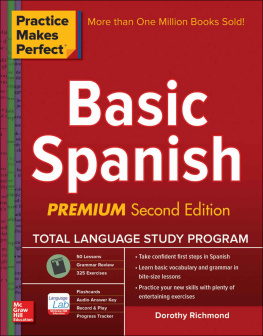Copyright 2015 by McGraw-Hill Education. All rights reserved. Except as permitted under the United States Copyright Act of 1976, no part of this publication may be reproduced or distributed in any form or by any means, or stored in a database or retrieval system, without the prior written permission of the publisher. ISBN: 978-0-07-183621-0
MHID: 0-07-183621-7 The material in this eBook also appears in the print version of this title: ISBN: 978-0-07-183620-3, MHID: 0-07-183620-9. eBook conversion by codeMantra
Version 1.0 All trademarks are trademarks of their respective owners. Rather than put a trademark symbol after every occurrence of a trademarked name, we use names in an editorial fashion only, and to the benefit of the trademark owner, with no intention of infringement of the trademark.
Where such designations appear in this book, they have been printed with initial caps. McGraw-Hill Education eBooks are available at special quantity discounts to use as premiums and sales promotions, or for use in corporate training programs. To contact a representative please visit the Contact Us page at www.mhprofessional.com. TERMS OF USE This is a copyrighted work and McGraw-Hill Education and its licensors reserve all rights in and to the work. Use of this work is subject to these terms. Except as permitted under the Copyright Act of 1976 and the right to store and retrieve one copy of the work, you may not decompile, disassemble, reverse engineer, reproduce, modify, create derivative works based upon, transmit, distribute, disseminate, sell, publish or sublicense the work or any part of it without McGraw-Hill Educations prior consent.
You may use the work for your own noncommercial and personal use; any other use of the work is strictly prohibited. Your right to use the work may be terminated if you fail to comply with these terms. THE WORK IS PROVIDED AS IS. McGRAW-HILL EDUCATION AND ITS LICENSORS MAKE NO GUARANTEES OR WARRANTIES AS TO THE ACCURACY, ADEQUACY OR COMPLETENESS OF OR RESULTS TO BE OBTAINED FROM USING THE WORK, INCLUDING ANY INFORMATION THAT CAN BE ACCESSED THROUGH THE WORK VIA HYPERLINK OR OTHERWISE, AND EXPRESSLY DISCLAIM ANY WARRANTY, EXPRESS OR IMPLIED, INCLUDING BUT NOT LIMITED TO IMPLIED WARRANTIES OF MERCHANTABILITY OR FITNESS FOR A PARTICULAR PURPOSE. McGraw-Hill Education and its licensors do not warrant or guarantee that the functions contained in the work will meet your requirements or that its operation will be uninterrupted or error free. Neither McGraw-Hill Education nor its licensors shall be liable to you or anyone else for any inaccuracy, error or omission, regardless of cause, in the work or for any damages resulting therefrom.
McGraw-Hill Education has no responsibility for the content of any information accessed through the work. Under no circumstances shall McGraw-Hill Education and/or its licensors be liable for any indirect, incidental, special, punitive, consequential or similar damages that result from the use of or inability to use the work, even if any of them has been advised of the possibility of such damages. This limitation of liability shall apply to any claim or cause whatsoever whether such claim or cause arises in contract, tort or otherwise. Companion Flashcard App
Flashcard sets for additional practice can be found in the McGraw-Hill Education Language Lab app. Go to mhlanguagelab.com for details on how to access this free app, which is available for Apple and Android tablet and mobile devices, as well as computer via web browser (best viewed with Chrome or Safari browser).
Contents
Preface
A French word may be a basic word, like English
soft, or a word with a prefix and/or a suffix, like
presoftened and
softly.
These two words are part of a family of words that have the base word soft. In a family of words, the base word is the common element and contains the main idea of the word. Knowing the meaning of the base word (soft) and the meanings of the prefix (pre-) and the suffixes (-en, -ed, and -ly) helps you recognize or infer the meaning of a word like presoftened or softly. To know the meaning of an affixed base word requires that you be familiar with the possible meanings of prefixes like pre- and suffixes like -ly. Fortunately, most French prefixes have recognizable English counterparts. Suffixes, however, differ quite a bit between French and English and require careful study.
A prefix is a letter or group of letters affixed to the beginning of a base word to add to or otherwise modify the base words meaning. For example, the adjective amoral is composed of the base word moral and the prefix a-, which adds the concept of not to the meaning of the adjective. The word moral means being concerned with right and wrong; the word amoral means not being concerned with right and wrong. A prefix does not change the function of the base word: moral and amoral are both adjectives. A suffix is a letter or group of letters affixed to the end of a base word to form a new, related word. For example, the suffix -ity added to the base word moral changes the adjective moral to the noun morality.
A suffix may change the function of a word; for example, fear is a noun, but fearful is an adjective. Some French suffixes are grammatical, including endings to mark infinitives, present participles, past participles, and adverbs. These suffixes and their uses are explained in .
Introduction
The French language relies on suffixes to mark parts of speech and gender. It relies on both suffixes and prefixes to modify base words and convey nuances of meaning.
Practice Makes Perfect: French Vocabulary Building with Suffixes and Prefixes will help you expand your vocabulary and comprehension, as well as gain an appreciation of the language through awareness of French suffixes and prefixes.
In this age of information and technology, it is easy to look up vocabulary and get translations online. You may even find lists of suffixes and prefixes; unfortunately, they are rarely accompanied by enough examples and they never offer in-depth analysis. By contrast, this book focuses on individual suffixes and prefixes, providing charts of words, along with their base words and the English equivalents of both. Of course, these charts are not exhaustivethere are simply too many suffixes and prefixes. You will, however, be exposed to about 4,000 words, and you will learn to modify many of the base words you already know and become an artisan of language as a result. The 160 suffixes and prefixes in this book deliver the most potential for expanding your vocabulary.
They also provide insight into families of words. The base words you have learned in your introductory French courses are but the stem of a flower. Starting with this stem, you can sketch out a beautifully blooming flower composed of many petals; these petals are the suffixed and prefixed words. The stem may be the root of the flower (frequently a Latin or Greek root), but more often, the stem is a French base word that grew out of a Latin or Greek root. This is why the term base word is used instead of root in the vocabulary charts. Practice Makes Perfect: French Vocabulary Building with Suffixes and Prefixes presents 100 suffixes and 60 prefixes, selected on the basis of their frequency and usage.
Some affixes are more common than others, but all are found in words you encounter in everyday conversation and reading, from magazine articles and newspapers to literature. Both suffixes and prefixes are grouped as beginning or intermediate/advanced. Each entry is presented with its basic meaning, its English equivalent if one exists, its part(s) of speech, and its gender if it is a noun. A short paragraph then explains and analyzes the suffix or prefix, specifying how it is used to form new words and providing other important information. At least one chart follows, presenting a list of words formed with the affix, their base words, and the English equivalents of both. If an affix appears predominantly in nouns, a chart of nouns is presented, followed by a list of related verbs and/or adjectives that are derived from the same base words as the nouns.








